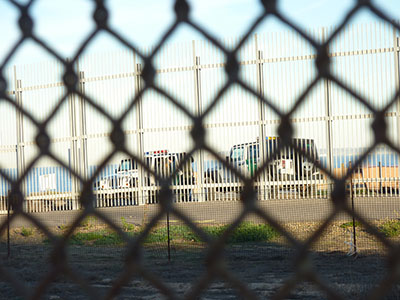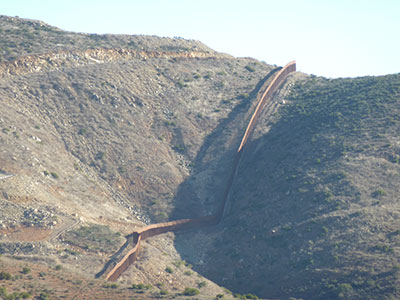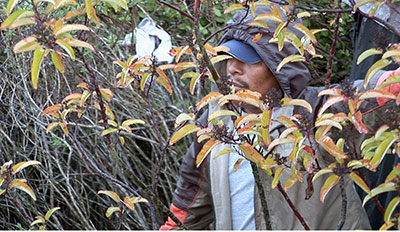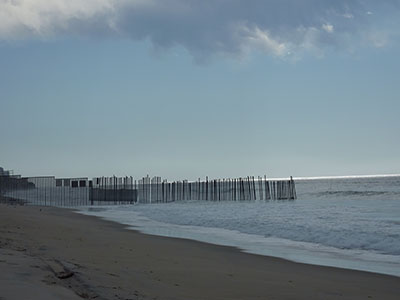In this five-part series, Greg Olear talks with Katie Arnoldi about how U.S. policies on marijuana and immigration are detrimental to our nation’s health. Click here to read from the beginning.
[GO]: You began your Point Dume research with the grow sites—all things marijuana, basically. Your interest, and expertise, then expanded to include the illegal immigration practice with the somewhat Orwellian name, human trafficking. How did this come about?
[KA]: Right, so I went into all those grow-sites and saw the different camps as research for the book. I knew I wanted to have a character on the inside of an operation. His name was Felix Duarte, and he was a really lovely guy in a terrible situation. Right from the get-go I had great sympathy for him, so I went out into the field and found him the nicest camp available then started building the details of his day-to-day off of the things that I saw—the kitchen set-up, the battered tent and ragged sleeping bag, the tortillas, flat of eggs, cans of jalapenos, the stick furniture, the latrine, the garbage pit. Once I had him situated, I had to research the cartel recruitment process and the border crossing stuff to figure out how he got there. I read a lot of accounts of people coming over and learned some hideous facts. Then I wrote Point Dume. It was published, and I tried to move on—I had another novel planned—but couldn’t forget the things I learned about Mexico. These people’s stories, the tragedies in their lives, the deaths and murders, the families left behind always wondering about the fate of their loved ones. The stuff haunted me—woke me up at night. So I decided I had to write about Mexico directly. I started going down to the border, interviewing people, reading everything I could get my hands on.
[GO]: This is, of course, rather dangerous, for reasons we’ll get to in a moment. Border crossing is not what it used to be. How does it work now?
[KA]: In the old days, crossing into the U.S. was an unorganized system of independent men working as guides for migrants. Typically a friend of a friend, who had experience crossing the border, would show you the best route for a few hundred dollars; families would refer one another to their favorite guide, and it was mostly done by word of mouth. It’s very different now, very organized. The drug trafficking organizations have essentially eliminated the independent guide. Either the coyote works for the cartel, or he doesn’t work at all. They control the smuggling routes and have armed militia on both sides of the border insuring that no one poaches on their territory. Today a migrant can expect to pay several thousand dollars to cross with a guide. There are opportunistic bandits everywhere and trigger-happy border agents on the U.S. side. Even with the cartel assistance it’s incredibly dangerous. Women have an especially difficult time; more often than not they are forced to perform sexual favors if they want to arrive safely at their destination. It is said that rape is part of the price of admission when crossing illegally into the United States.
[GO]: I want to talk more about the treatment of women, because it’s deplorable, but we’ll discuss that in Part IV. For now, I’ll add that if the cartels are involved, that must mean there’s money to be made.
[KA]: The drug smugglers realized that there was big money in trafficking people and so they moved in, took control and turned human smuggling into a huge and very profitable business. For the cartels, these poor and desperate people have become just another expendable commodity, like a bale of marijuana or a load of meth. Some believe that human trafficking has surpassed the drug trade in terms of profit.
[GO]: It’s frankly disgusting. On so many levels.
[KA]: Terrible things have happened, like that mass murder of 72 migrants in Tamaulipas in 2010, and then another killing in the same area of 193 people in 2011. Some speculate that at least one of these massacres was about the Zetas fighting to control the smuggling route and force the Gulf cartel out of the area, a sort of payback in which one group slaughtered another’s shipment. It’s hard to know what’s really going on with the constant power struggles. The one thing I can say for sure is that too many innocent people are dying. There are countless stories about the kidnappings and torture of migrants in order to extort money from relatives on both sides of the border. Sickening stuff.
[GO]: As Americans, we have this notion of our country being the best place on earth, the Land of the Free and so forth. But we also have this notion reinforced by people risking life and limb to enter the country, because, one presumes, living here as an illegal is preferable to living as a working stiff in Central America. Is this really true? Is Central America really so bad? And if so, why?
[KA]: Okay—first off I need to say that I absolutely love Mexico. It is a beautiful country with an incredibly rich culture and exceptionally lovely people. But Mexico, and most of Central America, is a very difficult place to live if you are poor and uneducated. There is little opportunity for the lower and even some middle-class families to advance their position due to inadequate education system and limited job opportunities. A number of factors, including and especially NAFTA, have made it almost impossible for the rural farming population to sustain itself on traditional agriculture. Our free trade agreement did bring a lot of manufacturing and revenue into Mexico, but it drove millions of impoverished farmers off their land and offered them very few alternatives.
[GO]: This is because of the elimination of tariffs, right?
[KA]: Farmers couldn’t afford to feed themselves or their families once the Mexican government subsidies dried up and the grain imports flooded the market. It became more economical for a Mexican farmer to buy a cheap bag of imported corn rather than grow the corn himself. So thousands of people abandoned their land and flooded the borders in search of employment. But of course there were not enough jobs in the maquiladoras (factories), and so unemployment and poverty exploded in those border cities like Tijuana and Mexicali.
[GO]: So they can either live in extreme poverty in Mexico (or elsewhere), or else come here and work like slaves. I understand why they need to come, but once they get paid, I can’t see why they’d prefer to stay.
[KA]: Today if you polled the migrant workers in the strawberry fields of Oxnard, California, and asked them if they’d rather be here or Mexico, I think 70 percent of them would tell you that they’d prefer to be living at home with their families. Before 9/11 and the tightening of our borders, a large percentage of migrant workers typically came to the US for a few months, worked the fields, and returned home at the end of the growing season. Back then, the borders were relatively porous and enforcement was much more lax because this migrant flow benefited everyone. The U.S. growers had an excellent supply of skilled labor willing to work for low wages. The migrants came for short periods, earned good money, and left. But then 9/11 happened, and we panicked about closing the borders so that terrorists couldn’t sneak in and attack us. Suddenly the migrants were unable return home at the end of the growing season because it was too hard to get back again. Their families were still starving in Mexico, they still needed the money, so they just stayed in the U.S. and continued to work. We tightened the border and our illegal population exploded.
[GO]: The law does exactly the opposite of what it’s supposed to do.
[KA]: This is our current border policy as I see it: We say to the Mexicans (and Guatemalans, and Hondurans, and Salvadorans, and Nicaraguans, etc.): you are forbidden to come here. We don’t want you and we’re going to make it as difficult as possible for you to get in by building huge border fences and barriers in all the accessible areas. We’ve closed off the safe routes of passage thereby funneling all illegal traffic through incredibly harsh desert and dangerous mountain terrain. Because the only option now is to cross in the most remote and brutal country, because you have to walk twice or three times as far as you used to, there’s a good chance you won’t make it. Either you’ll turn back from exhaustion or maybe you’ll get lost. If we don’t catch you, there’s a good chance you’ll die of exposure after a few days of wandering in the blistering deserts or over the freezing mountain passes. Your death is your problem, even if it’s on US soil, because we told you not to come. And if we do catch you, we will deport you. Don’t come. Do Not Come. BUT, but, but, but, if you do happen to make it across our border and you’re still in good health, swing on by Mecca, California, or hitch a ride up to the Salinas Valley or Tulare County or Merced because we need you to pick our grapes and cabbages and artichokes and kale.
Here’s my question: How come we don’t see huge raids when the asparagus is ready to be picked? Where are the Immigration and Customs Enforcement officers and the Border Patrol when our crops are ready to be harvested? Seems to me that if we really wanted to shut down all illegal immigration, we’d simply target the fruits and vegetables around the country, do sweeping raids when our food is ripe. But that doesn’t happen. That never happens. Because we can’t afford to eliminate the migrant population; there would be huge financial repercussions. Hell, we would all starve if we didn’t have workers in our fields, picking our foods.
So if you ask those migrants picking strawberries in Oxnard, why are they here? Why are they living in a tiny, rundown one-room apartment with ten or twelve other guys, sleeping on the floor, hiding from La Migra, and struggling to make ends meet? Why did they risk their lives to come to a country that doesn’t want them? Why do they put up with all the abuse and discrimination just to earn low wages that they send home to their families? Why do they keep coming? Why not just stay in Mexico? I think we have to circle back and take a further look at NAFTA and our ridiculous border policies to get at the real answer.
[GO]: Let’s go there, then. NAFTA, for North American Free Trade Agreement, was passed by President Clinton—an example, it was said at the time, of him working across the aisle. What does it do exactly?
[KA]: NAFTA is a free trade agreement between Canada, the U.S. and Mexico that was signed into law on January 1, 1994. It essentially eliminated import/export tariffs between the three countries and allowed for unrestricted trade. The policy was sold to the American public as a way to increase our revenue options while at the same time offering real financial opportunity to our impoverished neighbor.
[GO]: Did it help Mexico?
[KA]: There is no question that NAFTA benefited certain aspects of the Mexican economy. Exports increased substantially and there was a significant influx of foreign investment. But NAFTA had an absolutely devastating impact on the Mexican farmer. The U.S. flooded the Mexican market with our exported, subsidized agricultural goods, including corn, which is a primary crop in Mexico. Prices plummeted. Suddenly the peasant farmer found himself in competition with the United States of America, and within a few years he was earning something like 70 percent less for his corn harvest.
[GO]:Mexico vs. Monsanto.
[KA]: As I said before, it was cheaper to buy a bag of low-quality corn than grow it himself. He couldn’t support himself, he was poorly educated and had no other work options and his family couldn’t survive. And so he, and over two million others, abandoned their land and migrated to the cities, looking for work and a way to support their families. We put the independent Mexican farmer out of business.
[GO]: We’re good at that. We have experience in putting our own farmers out of business. But I imagine NAFTA helped us a lot more than it did Mexico.
[KA]: NAFTA was great for the U.S. economy. It allowed U.S. companies to start manufacturing in Mexico and then import those goods back into the U.S., tax-free. Hundreds of maquiladoras were built in cities all along the Mexican border. Electronics, clothing, furniture, appliances, auto parts, just about everything was being “Made in Mexico”.
[GO]: I know about the maquiladoras. They are mentioned quite a bit in 2666, the section about the murders of women in Juarez. But we’ll get to that later. Tell me more about the conditions there, which are basically a modern-day Exhibit A for the importance of labor unions.
[KA]: So what you had were are all these peasants flooding into the cities, desperately looking for work, and suddenly the manufacturers had a huge over-supply of labor. With virtually no government restrictions and a complete lack of organized unions, these companies could establish their own pay scale. Salaries plummeted. Today a young woman working in a maquiladora is probably earning less than $10 per day, some as little as $6 per day. There is no such thing as safety oversights or worker’s compensation and many of these factories are frankly dangerous. If someone is injured on the job, they’re fired. People do twelve-hour shifts for below-living wages. Many work two or even three jobs—if they are lucky enough to find the work—just to feed their families. The cities have been overwhelmed. Water, sewage, sanitation: it is impossible to keep up. The environmental fallout is a disaster. Thousands are homeless. Communities have sprung up in the city dumps; people living in cardboard shacks, literally surviving off garbage. Disease, crime, starvation, desperation. Is it any wonder that the influx of immigrants from Mexico to the U.S. has increased something like 300% since NAFTA?
[GO]: But that’s not the whole story. There’s also the part about how the law has been a boon to the cartels.
[KA]: NAFTA has been great for the drug business. In rural Mexico, you’ve got all these farmers desperate to feed their families. Cartel guys come in and say, “Forget corn. Grow our weed. We’ll pay you way more money than you’ve ever made before. And if you say no, we’ll rape your children and cut your head off.” No one says NO. Marijuana production has exploded. And up in the mountains there has been an increase in the cultivation of poppies for heroin.
But the best thing that NAFTA did for the drug trafficking organizations was to open up the shipping options. According to the Bureau of Transportation Statistics, in 2011 we had 4,858,057 trucks cross from Mexico into the United States. That’s almost five million trucks. In that same year, 61,180,268 passenger cars crossed our border. The sheer volume of traffic makes it impossible for border agents to thoroughly check each vehicle, especially the big shipping containers. I’ve read that as few as 5% of commercial trucks are actually inspected. Do the math. NAFTA presented the cartels with an extremely efficient way to deliver product to the customer.
[GO]: If I didn’t know better, I would have thought the cartels drafted the legislation. Wait…they didn’t, did they?
[KA]: NAFTA was a dream come true for drug trafficking organizations. With our free trade agreement we effectively created a new work force for the drug cartels and an economical way to deliver merchandise. And just so we’re clear, we are the customer. The United States of America is the target audience. We are the whole reason for this big mess. WE DID THIS. Without our insatiable need for intoxicants and our ridiculous anti-drug laws there would be no drug war. We are the sole source of fuel for this terrible fire.
[GO]: Obviously we need to use drugs to help us cope with the fact that our policies on marijuana and immigration are so self-defeating. Speaking of, how much of this is marijuana, do you think, compared to, say, meth and heroin and other hard drugs? My sense is that the most popular illegal drug of choice is pot, by a long shot. Am I right?
[KA]: Right, marijuana is the most widely used illegal drug in the United States but it’s really hard to know where it ranks in terms of profitability for the Mexican drug trafficking organizations. The cartels are providing us with a constant supply of heroin, methamphetamine, cocaine, and marijuana. The U.S. Justice Department estimates that they are earning $18-$39 billion dollars annually. How much of that is pot? Impossible to say. It’s not like we can check the tax returns. The only thing we know for sure is that they are making huge profits on all their drug sales.
[GO]: One of the many salient points in Point Dume—this one is made by the wonderfully-named Pablo Schwartz—is that no one has ever died of a marijuana overdose…that it’s physically impossible to consume as much as it would take to kill you. There’s no question that both alcohol and cigarette smoking are far worse in terms of addictive properties and adverse effects. And yet pot, which is called weed because that’s what it is, is verboten. How come? Who came up with this bright idea? Why pot and not tobacco?
[KA]: There are a lot of conspiracy theories out there. Some people believe that corporate America is behind the ban on marijuana. I’ve talked to pot activists who say the hemp poses a huge threat to the paper companies and textile mills.
[GO]: I’ve heard that one—that it was forced through by William Randolph Hearst, who owned the paper mills, and that it has more to do with eliminating hemp than getting high.
[KA]: There is belief that the drug companies funded much of the anti-marijuana propaganda because pot is an inexpensive alternative to a lot of the medicines that we take today for pain management and mood moderation. I honestly don’t know how we got here. I don’t understand why some people perceive marijuana as such a threatening substance because it’s really quite benign when compared with alcohol or highly addictive prescription painkillers.
[GO]: The Big Pharma theory makes sense to me. When a prohibition such as this one is so egregiously ill-advised and not in the public interest, my sense is always that some powerful if invisible faction is profiting too heavily on it for the law to change.
[KA]: The people who are profiting the most from our pot prohibition are the drug traffickers, which is completely insane. We need to legalize marijuana, across the board, in all states. By doing so, we will eliminate the illegal grow-sites on our public lands and end that environmental nightmare. We’ll take a big bite out of the Mexican drug business. If we regulate the market and tax the hell out of the product then we can take the profits away from the criminals and funnel that money into our failing economy.
In Part III, we discuss immigration.






